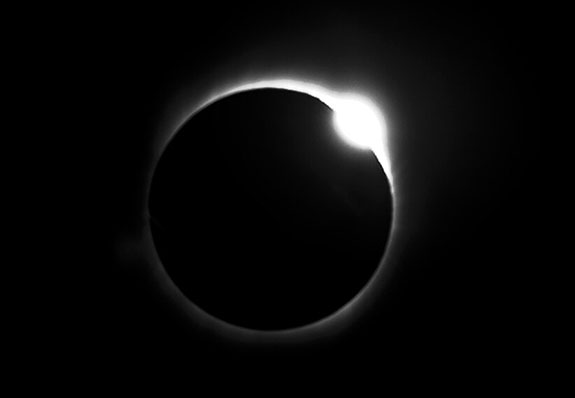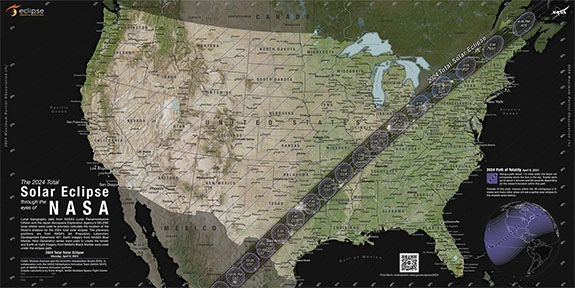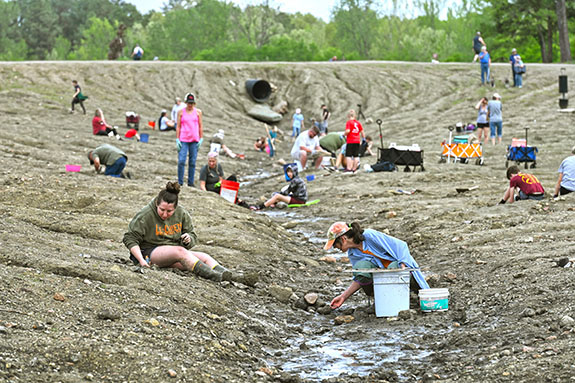Solar Eclipse: Sun, Moon Will Align to Create 'Diamond Ring Effect' on April 8
If you're lucky enough to live along the narrow path that runs from Eagle Pass, TX, to the eastern tip of Maine, April 8th will bring you a fantastical total solar eclipse, complete with a bonus celestial display that looks remarkably like a diamond ring.

The “Diamond Ring Effect,” which was first explained by Francis Baily in 1836, occurs when the moon completely masks out the sun during a total solar eclipse. Due to the rugged lunar landscape, the black outline of the moon is not smooth. Tiny beads of sunlight can still shine through in some places and not in others as the moon slowly grazes past the sun.
These are called Baily’s Beads. When only one dazzling “bead” remains, momentarily, the view of the eclipse resembles a diamond ring. The ring’s glow is produced by the sun’s corona remaining dimly visible around the lunar silhouette.

The Diamond Ring Effect will actually happen twice on April 8. The first time will occur in the moment just before the total eclipse, and the second will occur just after the total eclipse. The solar eclipse will last about 4.5 minutes in most locations along the path, and effectively turn day into night. The grey path shown on NASA's map is about 115 miles wide and represents the viewing area where the Moon will completely block out the Sun in the sky.
Skygazers southwest of San Antonio will experience the solar eclipse at approximately 1:30pm Central time, while those in the easternmost reaches of Maine will close out the US light show just after 3:30pm Eastern.

Ironically, one of the best places to view the “Diamond Ring Effect” on April 8 will be at Crater of Diamonds State Park in Murfreesboro, AR, the only diamond site in the world that’s open to the general public.
The park will experience 3 minutes and 48 seconds of the total eclipse, which will start at 1:47pm and last through 1:51pm. Visitors to the park on April 8 will see the start of a partial eclipse at 12:30pm and the end of the partial eclipse at 3:08 pm.
Reservations at the park are booking up fast, so those planning a trip to the park should order tickets online at this site…
While snacks and drinks are available in the Visitor Center while supplies last, guests are encouraged to bring a picnic lunch and plenty of water for every person in their group. Visitors are also encouraged to bring their own buckets, shovels, wagons, and sifting screens, as rental equipment is likely to sell out.
NASA warned that skywatchers should NEVER look at a partial solar eclipse without proper eye protection. Looking directly at the sun, even when it is partially covered by the moon, can cause serious eye damage or blindness. Only during totality, when the sun’s disk is completely covered by the moon, is it safe to view the eclipse with the naked eye, says NASA.
During the solar eclipse, the moon’s shadow will pass over half of the US. The path of the umbra, where the eclipse is total, will stretch on a fairly straight path from the Tex-Mex border to the Maine-New Brunswick border. Cities in a great position to view a total eclipse and the "Diamond Ring Effect" include Little Rock, Indianapolis, Cleveland, Buffalo and Burlington, VT.
Credits: Diamond ring solar eclipse photo by Lutfar Rahman Nirjhar, CC BY-SA 3.0, via Wikimedia Commons. Solar eclipse map by Michala Garrision and the Scientific Visualization Studio (SVS), in collaboration with the NASA Heliophysics Activation Team (NASA HEAT), part of NASA's Science Activation portfolio. Eclipse calculations by Ernie Wright, NASA Goddard Space Flight Center. Crater of Diamonds image courtesy of Arkansas State Parks.

The “Diamond Ring Effect,” which was first explained by Francis Baily in 1836, occurs when the moon completely masks out the sun during a total solar eclipse. Due to the rugged lunar landscape, the black outline of the moon is not smooth. Tiny beads of sunlight can still shine through in some places and not in others as the moon slowly grazes past the sun.
These are called Baily’s Beads. When only one dazzling “bead” remains, momentarily, the view of the eclipse resembles a diamond ring. The ring’s glow is produced by the sun’s corona remaining dimly visible around the lunar silhouette.

The Diamond Ring Effect will actually happen twice on April 8. The first time will occur in the moment just before the total eclipse, and the second will occur just after the total eclipse. The solar eclipse will last about 4.5 minutes in most locations along the path, and effectively turn day into night. The grey path shown on NASA's map is about 115 miles wide and represents the viewing area where the Moon will completely block out the Sun in the sky.
Skygazers southwest of San Antonio will experience the solar eclipse at approximately 1:30pm Central time, while those in the easternmost reaches of Maine will close out the US light show just after 3:30pm Eastern.

Ironically, one of the best places to view the “Diamond Ring Effect” on April 8 will be at Crater of Diamonds State Park in Murfreesboro, AR, the only diamond site in the world that’s open to the general public.
The park will experience 3 minutes and 48 seconds of the total eclipse, which will start at 1:47pm and last through 1:51pm. Visitors to the park on April 8 will see the start of a partial eclipse at 12:30pm and the end of the partial eclipse at 3:08 pm.
Reservations at the park are booking up fast, so those planning a trip to the park should order tickets online at this site…
While snacks and drinks are available in the Visitor Center while supplies last, guests are encouraged to bring a picnic lunch and plenty of water for every person in their group. Visitors are also encouraged to bring their own buckets, shovels, wagons, and sifting screens, as rental equipment is likely to sell out.
NASA warned that skywatchers should NEVER look at a partial solar eclipse without proper eye protection. Looking directly at the sun, even when it is partially covered by the moon, can cause serious eye damage or blindness. Only during totality, when the sun’s disk is completely covered by the moon, is it safe to view the eclipse with the naked eye, says NASA.
During the solar eclipse, the moon’s shadow will pass over half of the US. The path of the umbra, where the eclipse is total, will stretch on a fairly straight path from the Tex-Mex border to the Maine-New Brunswick border. Cities in a great position to view a total eclipse and the "Diamond Ring Effect" include Little Rock, Indianapolis, Cleveland, Buffalo and Burlington, VT.
Credits: Diamond ring solar eclipse photo by Lutfar Rahman Nirjhar, CC BY-SA 3.0, via Wikimedia Commons. Solar eclipse map by Michala Garrision and the Scientific Visualization Studio (SVS), in collaboration with the NASA Heliophysics Activation Team (NASA HEAT), part of NASA's Science Activation portfolio. Eclipse calculations by Ernie Wright, NASA Goddard Space Flight Center. Crater of Diamonds image courtesy of Arkansas State Parks.

